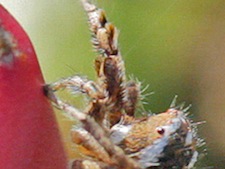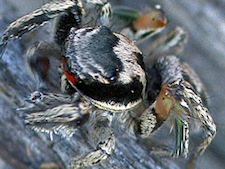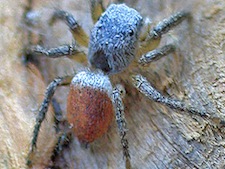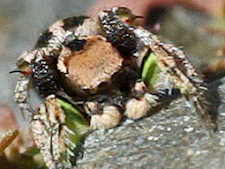Plexippoida: Pelleninae
The genus Habronattus comprises a diverse group of mainly North American jumping spiders. While Habronattus spiders are one of the representative groups of North American salticids they are most closely related to the largely Old World Pellenes. Habronattus adult males are strikingly marked and in the presence of potential mates (or other males) perform elaborate visual displays and, in some species, complimentary audio displays. Females (~4 mm to ~8 mm) are slightly larger than males (~3 mm to ~7 mm). Cryptic markings and muted colors are typical of females. Habronattus jumpers' third pair of legs ("leg III") is noticeably longer than the others. These spiders are terrestrial for the most part and Massachusetts' species favor open, sparsely vegetated areas including beaches, dunes, remnant glacial lake beds, old fields and woodland edges. Emergence schedules and peak seasons for adult activity vary with the species although Habronattus spiders are among the first jumpers to be found in early spring and remain active into the late fall.
Because of their relatively small size Habronattus jumpers can be difficult to locate. And while sweep netting may be fruitful with other groups you may find this technique less effective with these ground loving spiders. However, given the right habitat (see above) and a bit of patience Habronattus jumpers can often be located by just looking. It is useful to keep in mind that the spiders' movements (not yours) are the key. Once one individual is located the chances of finding others close by are excellent. Also, while some jumping spiders are "shy" to a fault Habronattus often tolerate a close approach. Because males are often moving and on the hunt you are more likely to see them first. Female Habronattus tend to be more sedentary.
Of the six species of Habronattus occurring in Massachusetts the immature males of all except H. decorus show some red scaling on the "face" (between the AER and the clypeus). Only H. coecatus males retains red scaling as an adult. Immature males showing a white clypeal band as well as red scaling in the ocular area are H. agilis, H. calcaratus, and H. viridipes; H. coecatus and H. borealis do not have white clypeal scaling.
Griswold, 1987; Tree of Life Jumping Spiders. Maddison, 1995; Hill and Edwards, 2013
-
agilis group: H. agilis
-males with vertical fringing on leg I and projecting hair tufts on sides of face
-males in the agilis group employ auditory displays in courtship
Habronattus agilis, the Massachusetts member of this group, was included by Emerton in his Supplement to the New England Spiders (1909). Emerton's drawings and descriptions of the males' courting behavior were based on observations he made in the coastal marshes of Ipswich, Massachusetts. Eight decades later Maddison and Stratton (1988) used H. agilis (in part) from Ipswich for their research demonstrating sound production in this group. Emerton gives August 1 as a time when both sexes are mature; other observations (Kaston, Walton, Murray) record mature males and females from June through October. Records for H. agilis in the state are exclusively from coastal areas.
-
coecatus group: H. coecatus, H. borealis
-males with lateral fringing on leg I and modified leg III
-males display intricate courtship behavior
 Nearly a third of all Habronattus spiders have both leg I fringing and leg III modifications. The coecatus and viridipes groups and their four Massachusetts' species are among this large assemblage. H. borealis is the exception to the rule lacking both characteristics mentioned above. Most H. coecatus records are from New York and southwards but this species was confirmed for MA in 2011. In contrast, H. borealis has a northerly range although there is a relic population in Arkansas. H. borealis records (MA) are primarily from coastal locales with adult males seen in early May and in late summer; the "red-faced" immatures appear in May and continue through fall. H. coecatus is a recent addition to the state list and as such records are limited. An adult male (worn and rubbed) was collected on 18 October 2011 (Middlesex Co). Immatures males were observed in the same locale throughout March of 2012 with an adult male collected on 5 May 2012. Both adult males and females were recorded in the spring of 2013 and mating was observed in May. See video.
Nearly a third of all Habronattus spiders have both leg I fringing and leg III modifications. The coecatus and viridipes groups and their four Massachusetts' species are among this large assemblage. H. borealis is the exception to the rule lacking both characteristics mentioned above. Most H. coecatus records are from New York and southwards but this species was confirmed for MA in 2011. In contrast, H. borealis has a northerly range although there is a relic population in Arkansas. H. borealis records (MA) are primarily from coastal locales with adult males seen in early May and in late summer; the "red-faced" immatures appear in May and continue through fall. H. coecatus is a recent addition to the state list and as such records are limited. An adult male (worn and rubbed) was collected on 18 October 2011 (Middlesex Co). Immatures males were observed in the same locale throughout March of 2012 with an adult male collected on 5 May 2012. Both adult males and females were recorded in the spring of 2013 and mating was observed in May. See video.
-
decorus group: H. decorus
 -males of each species show different leg modifications and courtship behaviors
-males of each species show different leg modifications and courtship behaviors
Nicholas Marcellus Hentz, the father of American arachnology, began his North American spider studies in Massachusetts. A record published by Hentz in 1846 under the synonym Attus roseus describes this jumping spider as " . . . not unfrequently (sic) found on grass, in May and June." I have seen adult females and imm. males in late April and have records for adults into late June. Kaston also gives records of males in May and from late summer into fall.
-
viridipes group: H. viridipes, H. calcaratus maddisoni

-males with lateral fringing on leg I and modified leg III
Both Massachusetts' species in the viridipes group are active in March on warm, sunny days. While H. viridipes is more common and occurs in a wider variety of habitats (including woodland edges), I have found the species together in several locales - always in sparsely vegetated areas with pebbles, rocks, and a sandy substrate. H. calcaratus maddisoni emerge from winter burrows in early spring and courtship occurs in the later half of March and into April. H. viridipes males mature slightly later with courtship in late April and May.
 Habronattus agilis
Habronattus agilis Habronattus borealis
Habronattus borealis Habronattus calcaratus
Habronattus calcaratus Habronattus coecatus
Habronattus coecatus Habronattus decorus
Habronattus decorus Habronattus viridipes
Habronattus viridipes